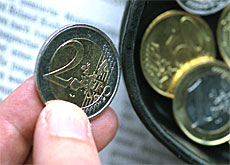
Euro proves to be an irritant

Scientists in Zurich have found that some euro coins can cause people to break out in a rash.
They say the presence of too much nickel in the coins is to blame for the skin problems.
The scientists from Zurich’s university hospital and the Federal Institute of Technology launched their study after people complained of adverse reactions to the one- and two-euro coins.
Tests carried out at the hospital showed that people who are allergic to nickel suffered blistering, redness of the skin and strong itching.
Seven patients took part in the tests, spending up to 72 hours with the coins taped to their skin. All of them displayed some form of cutaneous reaction.
“This is a standard allergy test around the world,” Frank Nestlé, a dermatologist who led the study, told swissinfo.
“This means that people who handle coins a lot could experience some irritation.”
Itchy feeling
According to Nestlé, the result is significant despite the small number of people tested. “All the patients showed some kind of symptom,” he said.
Around 15 per cent of population suffers from nickel allergies, the majority of them women.
The researchers said sweat eroded the metal in the coins, releasing up to 320 times the amount of nickel allowed under European Union guidelines.
The scientists also pointed out that the composition of the coins – an outer ring of yellow metal and an inner “pill” of white metal – was probably at fault.
“We think that the fact that these coins consist of two different nickel alloys enhances the nickel release, and therefore the skin reaction,” said Markus Speidel, a metals specialist at the Federal Institute of Technology.
“When sweat comes into contact with the two metals, it starts a reaction, releasing nickel ions that can penetrate human skin.”
Coin corrosion
Contact with human sweat also corrodes the coins. A euro suspended in artificial sweat turned brown after 36 hours exposure.
Only the one- and two-euro coins are apparently at fault according to the scientists.
“These coins contain two metals, unlike others that have just one nickel alloy,” Speidel told swissinfo.
The researchers are now considering whether to increase the scope of their study, but there could be a major pitfall.
“Switzerland is not a part of the euro zone,” said Nestlé. “It would be difficult for us to conduct a true user study.”
The European Commission says it will probably look at the results of the study, published in this week’s edition of the scientific journal Nature.
However, an official said on Wednesday that the decision on the metal content of the coins had been carried out after three different studies.
He added that the European nickel directives were designed for objects such as jewellery, which remain in prolonged contact with the skin – unlike coins.
swissinfo, Scott Capper
Fifteen per cent of the population suffers from nickel-related allergies.
Only one- and two-euro coins provoke allergic reactions according to the study.
These coins use two different types of nickel alloys.

In compliance with the JTI standards
More: SWI swissinfo.ch certified by the Journalism Trust Initiative

























You can find an overview of ongoing debates with our journalists here . Please join us!
If you want to start a conversation about a topic raised in this article or want to report factual errors, email us at english@swissinfo.ch.